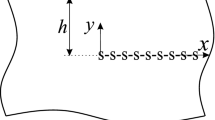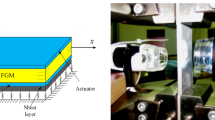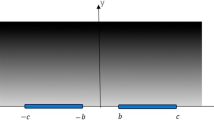Abstract
The fracture behavior of a functionally graded magneto-elastic plane with multiple parallel cracks is examined in this article. Under anti-plane mechanical, in-plane electric, and magnetic loadings, it is assumed that the cracks are either of the magneto-electrically impermeable or permeable types. Here, three distinct crack configurations are taken into consideration. For each of the three crack configuration cases, the boundary collocation and least square methods are used to obtain the semi-analytical expressions of the stress intensity factors (SIFs) at the crack tips. SIFs are used to calculate the stress magnification factors (SMFs). The novelty of the article is the study of shielding and amplification tendencies of cracks under the impact of functionally graded parameter, geometric size, and electric and magnetic loads. The graphical illustrations of SMFs as a function of gradient parameter, the distance between the cracks, and electric and magnetic loadings for three different crack configurations are the key features of the article.















Similar content being viewed by others
References
Naebe, M., Shirvanimoghaddam, K.: Functionally graded materials: a review of fabrication and properties. Appl. Mater. Today 5, 223–245 (2016). https://doi.org/10.1016/j.apmt.2016.10.001
Ma, L., Li, J., Abdelmoula, R., et al.: Mode III crack problem in a functionally graded magneto-electro-elastic strip. Int. J. Solids Struct. 44(17), 5518–5537 (2007). https://doi.org/10.1016/j.ijsolstr.2007.01.012
Cheng, J., Sun, B., Wang, M., et al.: Analysis of III crack in a finite plate of functionally graded piezoelectric/piezomagnetic materials using boundary collocation method. Arch. Appl. Mech. 89(2), 231–243 (2019). https://doi.org/10.1007/s00419-018-1462-y
Chue, C.H., Hsu, W.H.: Antiplane internal crack normal to the edge of a functionally graded piezoelectric/piezomagnetic half plane. Meccanica 43(3), 307–325 (2008). https://doi.org/10.1007/s11012-007-9096-0
Fu, J., Hu, K., Chen, Z., et al.: A moving crack propagating in a functionally graded magnetoelectroelastic strip under different crack face conditions. Theor. Appl. Fract. Mech. 66, 16–25 (2013). https://doi.org/10.1016/j.tafmec.2014.01.007
Govorukha, V., Kamlah, M.: An analytically-numerical approach for the analysis of an interface crack with a contact zone in a piezoelectric bimaterial compound. Arch. Appl. Mech. 78(8), 575–586 (2008). https://doi.org/10.1007/s00419-007-0179-0
Zhou, Z., Zhang, P., Wu, L.: Multiple parallel symmetric permeable model-III cracks in a piezoelectric/piezomagnetic composite material plane. Acta Mech. Solida Sin. 23(4), 336–352 (2010). https://doi.org/10.1016/S0894-9166(10)60035-3
Bagheri, R., Monfared, M.M.: Magneto-electro-elastic analysis of a strip containing multiple embedded and edge cracks under transient loading. Acta Mech. 229(12), 4895–4913 (2018). https://doi.org/10.1007/s00707-018-2289-x
Milan, A.G., Ayatollahi, M.: Transient analysis of multiple interface cracks between two dissimilar functionally graded magneto-electro-elastic layers. Arch. Appl. Mech. 90(8), 1829–1844 (2020). https://doi.org/10.1007/s00419-020-01699-y
Jin, Z.H., Feng, Y.Z.: Thermal fracture resistance of a functionally graded coating with periodic edge cracks. Surf. Coat. Technol. 202(17), 4189–4197 (2008). https://doi.org/10.1016/j.surfcoat.2008.03.009
Feng, Y., Jin, Z.: Thermal fracture of functionally graded plate with parallel surface cracks. Acta Mech. Solida Sin. 22(5), 453–464 (2009). https://doi.org/10.1016/S0894-9166(09)60296-2
Mottaghian, F., Darvizeh, A., Alijani, A.: A novel finite element model for large deformation analysis of cracked beams using classical and continuum-based approaches. Arch. Appl. Mech. 89(2), 195–230 (2019). https://doi.org/10.1007/s00419-018-1460-0
Nguyen, V.T., Hwu, C.: Analytical solutions and boundary element analysis for holes and cracks in anisotropic viscoelastic solids via time-stepping method. Mech. Mater. 160(103), 964 (2021). https://doi.org/10.1016/j.mechmat.2021.103964
Singh, R., Das, S.: Investigation of interactions among collinear Griffith cracks situated in a functionally graded medium under thermo-mechanical loading. J. Therm. Stresses 44(4), 433–455 (2021). https://doi.org/10.1080/01495739.2020.1843379
Singh, R., Das, S.: Transient response of collinear Griffith cracks in a functionally graded strip bonded between dissimilar elastic strips under shear impact loading. Compos. Struct. 263(113), 635 (2021). https://doi.org/10.1016/j.compstruct.2021.113635
Singh, R., Das, S.: Mathematical study of an arbitrary-oriented crack crossing the interface of bonded functionally graded strips under thermo-mechanical loading. Theor. Appl. Fract. Mech. 117(103), 170 (2022). https://doi.org/10.1016/j.tafmec.2021.103170
Singh, R., Das, S.: Schmidt method to study the disturbance of steady-state heat flows by an arbitrary oriented crack in bonded functionally graded strips. Compos. Struct. 287(115), 329 (2022). https://doi.org/10.1016/j.compstruct.2022.115329
Muskhelishvili, N.I.: Some basic problems of the mathematical theory of elasticity, vol 17404, no. 6.2, p. 1. Noordhoff, Groningen (1963)
Williams, M.L.: On the stress distribution at the base of a stationary crack. J. Appl. Mech. 24(1), 109–114 (2021). https://doi.org/10.1115/1.4011454
Isida, M.: Effect of width and length on stress intensity factors of internally cracked plates under various boundary conditions. Int. J. Fract. Mech. 7(3), 301–316 (1971). https://doi.org/10.1007/BF00184306
Ming, Z.Z., Cheng, J.S., Ping, X.H.: An improved method of collocation for the problem of crack surface subjected to uniform load. Eng. Fract. Mech. 54(5), 731–741 (1996). https://doi.org/10.1016/0013-7944(95)00187-5
Newman, JC.: Stress analysis of simply and multiply connected regions containing cracks by the method of boundary collocation (1969)
Cheung, Y.K., Woo, C.W., Wang, Y.H.: The stress intensity factor for a double edge cracked plate by boundary collocation method. Int. J. Fract. 37(3), 217–231 (1988). https://doi.org/10.1007/BF00045864
Wang, Y.H., Tham, L.G., Lee, P.K.K., et al.: A boundary collocation method for cracked plates. Comput. Struct. 81(28), 2621–2630 (2003). https://doi.org/10.1016/S0045-7949(03)00324-9
Acknowledgements
The authors are extending their heartfelt thanks to the revered reviewers for their suggestions toward the improvement of the article. The second author (Subir Das) acknowledges the project grant provided by the National Board for Higher Mathematics (NBHM), Department of Atomic Energy, Government of India (File No. 02011/2/2022 NBHM (R.P.)/R &D II / 2171).
Author information
Authors and Affiliations
Corresponding author
Ethics declarations
Conflict of interest
The authors have no competing interests to declare that are relevant to the content of this article.
Additional information
Publisher's Note
Springer Nature remains neutral with regard to jurisdictional claims in published maps and institutional affiliations.
Rights and permissions
Springer Nature or its licensor (e.g. a society or other partner) holds exclusive rights to this article under a publishing agreement with the author(s) or other rightsholder(s); author self-archiving of the accepted manuscript version of this article is solely governed by the terms of such publishing agreement and applicable law.
About this article
Cite this article
Singh, R., Das, S. Analysis of multiple parallel cracks in a functionally graded magneto-electro-elastic plane using boundary collocation method. Arch Appl Mech 93, 4497–4516 (2023). https://doi.org/10.1007/s00419-023-02506-0
Received:
Accepted:
Published:
Issue Date:
DOI: https://doi.org/10.1007/s00419-023-02506-0




